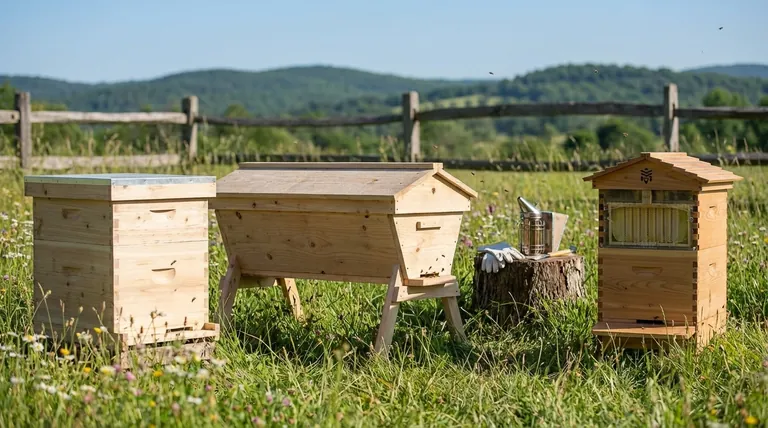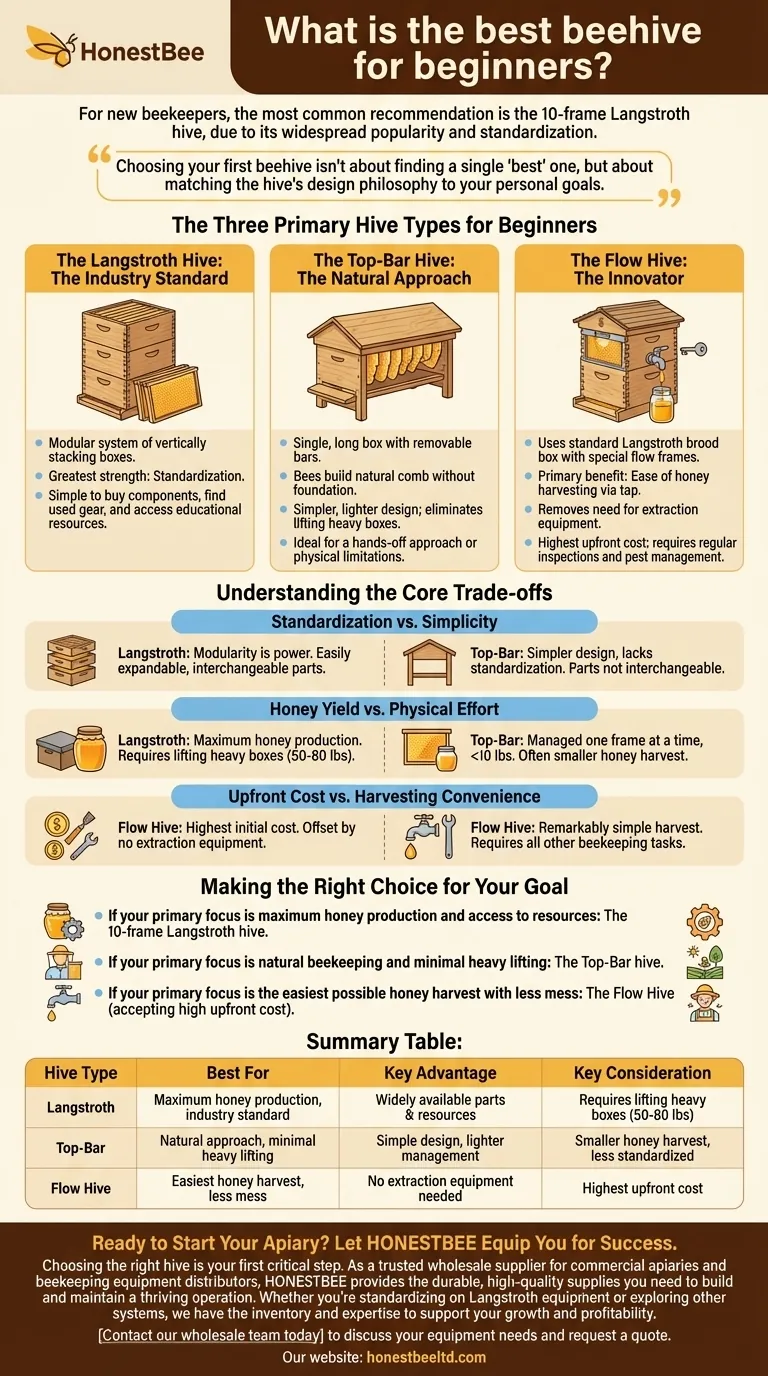For new beekeepers, the most common recommendation is the 10-frame Langstroth hive. This is almost entirely due to its widespread popularity and standardization, which makes finding equipment, replacement parts, and educational resources far easier than with any other system.
Choosing your first beehive isn't about finding a single "best" one, but about matching the hive's design philosophy to your personal goals. The right choice depends on whether you prioritize maximum honey production, a more natural approach with less heavy lifting, or the convenience of harvesting.

The Three Primary Hive Types for Beginners
Understanding the fundamental design of each hive is the first step. Each system was created with a different beekeeping philosophy in mind, which results in distinct advantages and disadvantages.
The Langstroth Hive: The Industry Standard
The Langstroth is a modular system of vertically stacking boxes. The lower boxes (brood boxes) are for the bees to raise their young, while the upper, shallower boxes (honey supers) are where they store surplus honey.
Its greatest strength is standardization. Virtually all beekeeping equipment in North America is designed to fit a Langstroth hive, making it simple to buy new components or find used gear.
The Top-Bar Hive: The Natural Approach
A Horizontal Top-Bar hive is a single, long box with removable bars laid across the top. Bees build their comb down from these bars naturally, without the use of pre-made frames or foundation.
This design is simpler, lighter, and eliminates the need to lift heavy boxes full of honey. This makes it ideal for those who want a more hands-off approach or have physical limitations.
The Flow Hive: The Innovator
The Flow Hive uses a standard Langstroth brood box for the bees but replaces the traditional honey supers with special, pre-formed plastic frames. A turn of a key splits the honeycomb cells, allowing honey to drain out through a tap.
Its primary benefit is the ease of honey harvesting, which removes the need for expensive extraction equipment. However, it is the most expensive option upfront.
Understanding the Core Trade-offs
Your decision will ultimately come down to balancing three key factors: effort, cost, and beekeeping philosophy.
Standardization vs. Simplicity
The Langstroth hive's modularity is its power. You can easily expand it, and every part is interchangeable.
The Top-Bar hive is far simpler in design but lacks standardization. Parts are not interchangeable between hives from different manufacturers, but they are often simple enough to build yourself.
Honey Yield vs. Physical Effort
Langstroth hives are designed for maximum honey production but require lifting heavy boxes that can weigh 50-80 pounds each.
Top-Bar hives are managed one frame at a time, so you never lift more than about 10 pounds. The trade-off is often a smaller honey harvest compared to a Langstroth.
Upfront Cost vs. Harvesting Convenience
The Flow Hive has the highest initial cost by a significant margin. This cost is offset by not needing to buy separate honey extraction tools like uncapping knives or spinners.
While the honey harvest is remarkably simple, all other beekeeping tasks remain. You will still need to perform regular hive inspections, manage pests like varroa mites, and ensure your colony is healthy.
Making the Right Choice for Your Goal
Select your first hive based on what you want to achieve as a beekeeper.
- If your primary focus is maximum honey production and access to resources: The 10-frame Langstroth hive is the undisputed industry standard for a reason.
- If your primary focus is natural beekeeping and minimal heavy lifting: The Top-Bar hive offers a simpler, more accessible, and less physically demanding experience.
- If your primary focus is the easiest possible honey harvest with less mess: The Flow Hive is an excellent choice, provided you accept the high upfront cost and understand that all other beekeeping duties still apply.
Understanding these core differences empowers you to begin your beekeeping journey with confidence and the right equipment for your vision.
Summary Table:
| Hive Type | Best For | Key Advantage | Key Consideration |
|---|---|---|---|
| Langstroth | Maximum honey production, industry standard | Widely available parts & resources | Requires lifting heavy boxes (50-80 lbs) |
| Top-Bar | Natural approach, minimal heavy lifting | Simple design, lighter management | Smaller honey harvest, less standardized |
| Flow Hive | Easiest honey harvest, less mess | No extraction equipment needed | Highest upfront cost |
Ready to Start Your Apiary? Let HONESTBEE Equip You for Success.
Choosing the right hive is your first critical step. As a trusted wholesale supplier for commercial apiaries and beekeeping equipment distributors, HONESTBEE provides the durable, high-quality supplies you need to build and maintain a thriving operation. Whether you're standardizing on Langstroth equipment or exploring other systems, we have the inventory and expertise to support your growth and profitability.
Contact our wholesale team today to discuss your equipment needs and request a quote.
Visual Guide

Related Products
- Langstroth Bee Hives Bee Keeping Box for Beginners Beekeeping
- Honey Flow Garden Bee Hive Flow Hive Best Beehive for Beginners
- HONESTBEE Professional Multi-Functional Hive Tool with Ergonomic Wood Handle
- HONESTBEE Advanced Ergonomic Stainless Steel Hive Tool for Beekeeping
- HONESTBEE Professional Long Handled Hive Tool with Precision Cutting Blade
People Also Ask
- Why were wooden hives traditionally preferred? For Natural Beekeeping Aligned with Bee Biology
- Should a beginner try a different type of hive? Start with a Langstroth for a solid foundation.
- Why are Langstroth hives recommended for beginners? Unmatched Support & Standardization
- What are the different types of beehive boxes available? Choose the Right Hive for Your Apiary
- How does the ease of access differ between 8-frame and 10-frame hives? Choose the Right Hive for Your Body



















